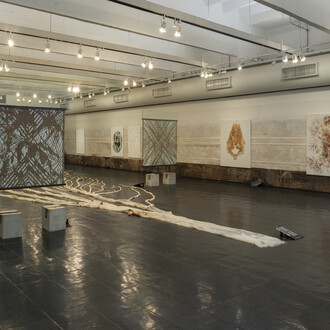Tiago Mestre, a Portuguese artist who has gained prominence in the Brazilian art scene, exhibits his works for the first time at Galeria Millan from July 12 through August 12. The show, Noite. Inextinguível, inexprimível noite. [Night. Inextinguishable, inexpressible night.], borrows its title from the poem Lugar II by Portuguese poet Herberto Helder (1930-2015) and features a selection of 60 artworks that explore the issue of form and the myth of the modern project relating to sculpture. Materials such as clay, bronze and plaster give shape to works that are in a constant negotiation between design and unpredictability, between plan and expressive freedom. The set of works includes sculptures of different scales, video, interventions with the gallery’s architecture and a large installation (a landscaping element that organizes the whole exhibition). These works refer to the first human attempts at assimilating the natural within projectual thought, mapping the process of assimilating the landscape starting from the intellect. “The idea of the design as a backdrop, as the orchestration of a system," explains Mestre.
Each of the sculptures seems to demonstrate a concise act, that’s clearly manual, as if it were unfinished or in a perpetual state of becoming, often leaving an ambiguous affiliation as to its disciplinary nature. The use of color emerges punctually, not so much as a system, but rather as a resource that accentuates, corrects or clarifies specific issues in the work. This semantic uncertainty, or programmatic transversality, is one of the focal points of the work. The problematization of the performative capacity of each of the works is made evident (if not parodied) in situations such as the one of the sculpture of two hills (a work that is both landscape sculpture and a niche for other minor works).
The video, which will be shown on the second floor of the gallery, stands as a kind of general synthesis of the show. The immateriality of this medium contrasts decisively with the predominantly objectual side of the remaining works. In it, we see a slow, silent and interminable transmutation of geometric and organic forms, in an “apathetic” reference to the myth of Brazilian architecture, to its unique relationship with nature and the landscape.
Although some architectural procedures are involved in his process—such as sketches and scale models—his focus is more directed toward the observation of the bodies' experience in the space, whether they be natural, sculptural, or architectural. It seems that this intimacy between nature, space and form, is what Mestre’s exhibition seeks to unveil.









![Jonathas de Andrade, Permanência relâmpago [Permanent lightning strike], exhibition view. Courtesy of Nara Roesler Gallery](http://media.meer.com/attachments/03afb5a3d2a3e9aca7766a552694cdec5f5d7b49/store/fill/330/330/dfece37312f3035d8071009c4bbecca3d9e69d863e94c3756e2146813cec/Jonathas-de-Andrade-Permanencia-relampago-Permanent-lightning-strike-exhibition-view-Courtesy-of.jpg)




